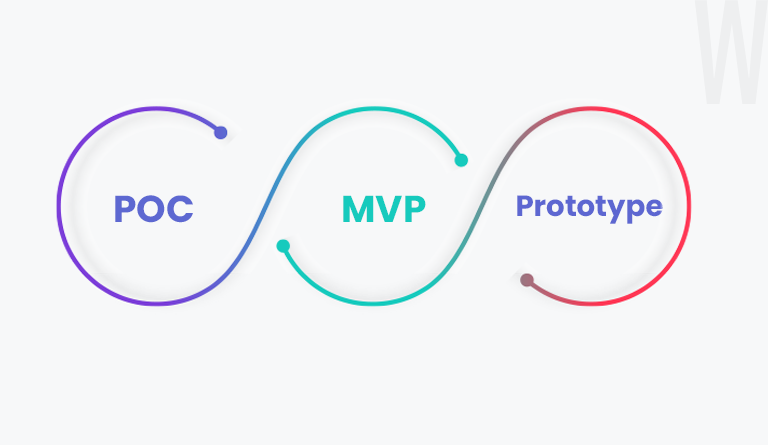TABLE OF CONTENT
Have you ever wondered about the process behind building exceptional mobile apps? It’s important to follow a recipe for success, where selecting the perfect ingredients can determine whether your application will be a hit or a flop.
There are three main players in this application development game: Proof of Concept (POC), Minimum Viable Product (MVP), and Prototype. These are like the seasoning that gives your application that extra kick and makes it a hit with users. This guide is like having a friendly chat with your GPS; it helps you navigate the twists and turns of these strategies. We’re going to break down why each one matters, what good they bring to the table, and the potential problems you should be ready to dodge.
Ready to dive into the POC vs. MVP vs. Prototype adventure? Let’s roll up our sleeves and uncover what makes each of them special.
Proof of Concept (POC): Laying the Foundation
Imagine that you have come up with an innovative idea for a mobile app that could potentially transform the way people manage their daily tasks. However, before investing significant time and resources into the app’s development, it’s very essential to validate the feasibility of your idea. This is where Proof of Concept (POC) comes into the picture.
A Proof of Concept is a preliminary version of your app that focuses on testing the core idea or innovation. It is designed to determine whether your concept is technically achievable and holds promise for further development. POCs typically contain only the essential functionalities required to display the unique aspects of your idea.
For instance, if your app concept involves a gesture-based control system, a POC would demonstrate this feature’s feasibility and assess its potential user appeal. This can be done by creating a basic version of the app that showcases the innovative control mechanism. By doing so, you can gather valuable feedback from stakeholders and potential users. This feedback is crucial in determining whether your idea is worth pursuing further.
Minimum Viable Product (MVP): The Building Blocks
Once your POC has validated your idea’s feasibility and potential, it’s time to tilt our heads toward the development of a Minimum Viable Product (MVP). An MVP is a version of your app that includes the core features necessary to provide value to users. Unlike the POC, which primarily focuses on testing feasibility, the MVP’s objective is to gather real-world feedback and validate your assumptions about user preferences and needs.
In the case of the task management app that we discussed previously with its innovative gesture-based control system, the MVP would include the essential features required for basic task management alongside the unique control mechanism. The goal is to release a functional version of the app to real users and gain insights into how they interact with the app and its innovative features.
As users start to interact with the app and provide feedback, you can make informed decisions about what features to prioritize, enhance, and eliminate. This feedback ensures that your app evolves based on actual user needs, leading to a more refined and user-centric final product.
Prototype: Crafting the User Experience
While POCs and MVPs focus on functionality and feasibility, Prototypes focus on the user experience and visual design of your app. A Prototype is a visual representation of your app’s interface, interaction design, and overall user journey. It’s like creating a mockup that allows stakeholders and potential users to envision what the final product will look and feel like.
Prototypes are non-functional; they don’t have the full technical backend of the app. Instead, they focus on presenting the app’s design, user interface elements, and interactions through clickable mockups. Prototypes serve as a powerful communication tool that bridges the gap between developers, designers, and stakeholders, helping everyone visualize the end product.
Continuing with the previous task management app example, a Prototype would showcase not only the gesture-based control system but also the layout of the task management interface, the color scheme, typography, and navigation flow. By having a representation of the app’s visual and interactive aspects, you can gather feedback on design choices and ensure that the user experience aligns with your vision and user expectations.
Choosing the Right Strategy: POC, MVP, and Prototype
When it comes to selecting the right strategy, POC, MVP, or Prototype, there’s no one-size-fits-all answer. The choice depends on your app’s nature, goals, and current stage of development.
POC vs. MVP: Early Validation vs. User Feedback
If you’re at the ideation stage and want to validate a unique concept or innovation, starting with a POC can be beneficial. POCs are ideal for early validation and to secure initial support from stakeholders. However, if your concept has been validated and you’re aiming to develop a functional version of the app while gathering user insights, an MVP is the way to go. MVPs allow you to build a solid foundation based on real user feedback, which in turn enhances your app.
Prototype: Polishing the User Experience
Prototypes come into play once you have a clear direction for your app’s functionality and want to refine the user experience even more. They’re especially useful when you need to communicate your app’s design to stakeholders, designers, and developers. A Prototype ensures that everyone involved in the project has an understanding of the app’s visual identity and interactions.
The Road to Product-Market Fit
The ultimate goal of utilizing POCs, MVPs, and Prototypes is to achieve the Product-Market Fit standard. This is the point where your app perfectly aligns with user needs and market demands. This alignment ensures that your app stands out in the crowded app marketplace.
Therefore, it’s better to start off with a POC to validate your innovative ideas. Once validated, transition to an MVP to build a functional version of your app while collecting user feedback for refinement. Simultaneously, create a Prototype to visualize the user experience and gather feedback on design choices. Remember, these strategies are not mutually exclusive; they can be combined and customized to your app’s specific needs. With the development of POCs, MVPs, and Prototypes, you can create an app that not only functions well but also satisfies users and achieves lasting success in the market.
Conclusion
To conclude, Proof of Concept, Minimum Viable Product, and Prototype serve as pillars that guide developers throughout the journey of application development. Starting with a POC to validate ideas, transitioning to an MVP for user-focused development, and crafting a Prototype for visual alignment can make all the difference.
As you embark on the app development journey, customize your approach to attain Product-Market fit, a destination every developer aspires to achieve. W2S Solutions shines as a leading mobile app development company, excelling in harnessing Proof of Concept (POC), Minimum Viable Product (MVP), and Prototype strategies. Starting with a solid POC validates innovative ideas, saving time and resources. Transitioning to MVP, W2S Solutions crafts user-focused solutions that align with market demands. Their expertise in Prototyping ensures exceptional user experiences.
Remember, while these strategies offer distinct benefits, the key lies in their integration. A harmonious blend of POCs, MVPs, and Prototypes ensures that your app resonates with users and finds its place in the competitive market. As you embark on your app development journey, consider the strengths of each strategy and tailor your approach to achieve the perfect Product-Market Fit – the destination every app developer dreams of.
Frequently Asked Questions
Get inspired!
Subscribe to our newsletter and get updates on how to navigate through disruption and make digital work for your business!


